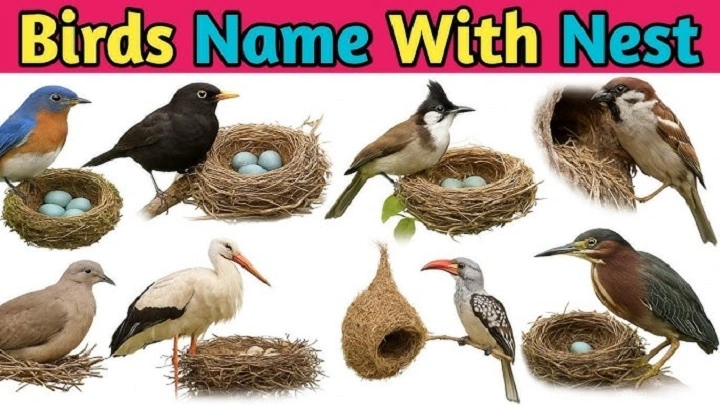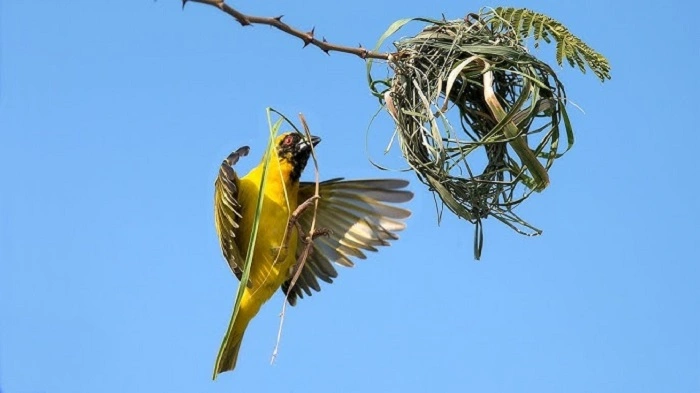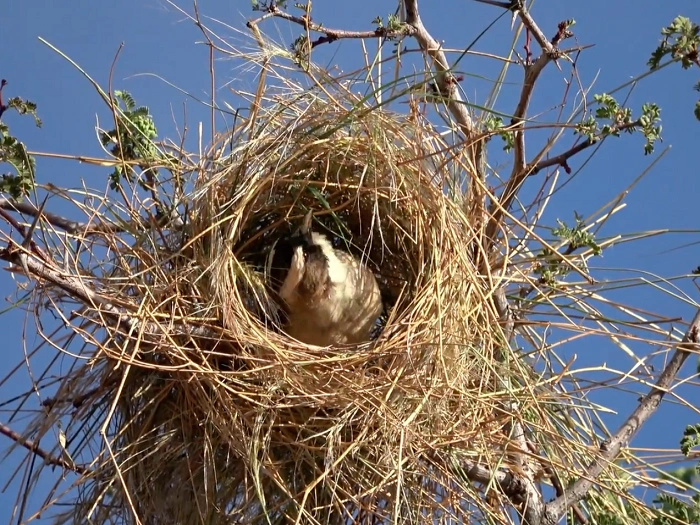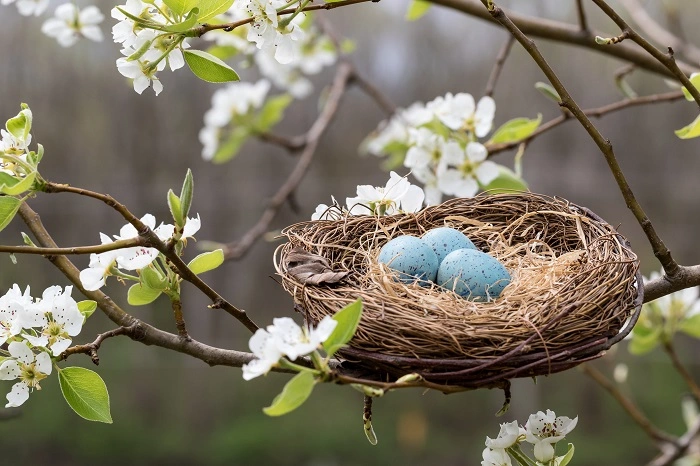Birds are everywhere. In cities, jungles, beaches, and even the most remote tundras. But what is so fascinating about them compared to any other animal is not necessarily that they are able to fly, but that they are compelled to build. Plans or equipment are not needed by birds; they build structures that are secure, practical, and occasionally stunning.
An illustration of a bird’s nest shows us how differently each group of birds builds. Some are tiny grass cups. Some are stick platform nests that a man can stand on. Some are dug into the ground, others hanging off sticks precariously. All are the result of survival techniques developed over thousands of years.
This guide explores bird nests in detail. We’ll look at common and rare examples, types of nests, regional differences, conservation, and the cultural meaning of these natural homes.
Why Birds Build Nests
Not all birds build nests. Some, like cuckoos, lay eggs in other birds’ homes. But for most species, nests are essential.
- Protection – A nest hides eggs and chicks from predators.
- Warmth – A good nest keeps sensitive chicks dry and safe from the wind.
- Success in breeding – Without a nest, most birds cannot breed safely.
- Survival – Nests increase the chances of a species surviving to the future.
A bird’s nest is an investment in its future and family life.
Types of Bird Nests
- Cup Nests – Most frequent. Cozy, spherical, bowl-shaped. Built by sparrows, robins, hummingbirds.
- Platform Nests – Large. Wide and strong. Used entirely by eagles, storks, ospreys. These are used for decades.
- Cavity Nests – Built inside holes or cavities. Used to capacity by woodpeckers, hornbills, and owls.
- Hanging or Woven Nests – Stranded baskets hanging from branches. Weaver birds and orioles are famous for these.
- Ground Nests – Plain scratch marks on sand, grass, or pebbles. Used by plovers, terns, ostriches, and penguins.
- Burrow Nests – Burrows dug into soil or sand. Kingfishers, bee-eaters, and puffins utilize them.
- Mound Nests – Sand or vegetation masses. Incubate eggs with seaweed heat of rot or the sun, which is used by Megapodes.
Well-Known Birds and Their Nesting Habits
- Sparrows – Build very small cup-shaped nests on branches or walls. Often use grass, straw, and feathers.
- Robins – Build neat cup-shaped nests made of mud and grass. Often spotted on ledges, branches, or fences.
- Crows – Construct ramshackle plastic, stick, and wire platform nests. Remarkably strong for their appearance.
- Pigeons – Tiny twig nests. Common on roofs, ledges, and bridges.
- Weaver Birds – Construct suspended woven nests with extremely tight openings. Tree trunks are covered in dozens by whole colonies.
- Hummingbirds – Extremely tiny nests less than a walnut. Spider webs, moss, and leaves are utilized to construct them.
- Woodpeckers – Drilled holes within tree trunks. Hiding spots from predators.
- Eagles – Construct enormous platform nests referred to as eyries. Some weigh more than a ton after several decades of usage.
- Penguins – Deposit eggs on the ground in scrapes. Emperor penguins keep eggs on their feet.
- Flamingos – Build big mud mound nests to keep eggs above water.
- Hornbills – Trap the female into a mud cavity nest with only a feeding slit being left open.
- Albatrosses – Ground-nest in distant colonies. Recycle the same nests for many years.
- Swallows – Construct mud cup nests on buildings or rafters.
- Storks – Construct huge platform nests on rooftops, chimneys, and poles.
The Chart of Birds and Their Nests
| Bird | Type of Nest | Nesting Materials | Location of Nest |
| Sparrow | Cup | Grass, straw, feathers | Trees, shrubs, houses |
| Robin | Cup | Mud, grass, twigs | Ledges, branches |
| Crow | Platform | Twigs, wire, plastic | Tall trees, poles |
| Pigeon | Platform | Twigs, roots | Building ledges, cliffs |
| Weaver Bird | Hanging/Woven | Grass, palm fibers | Branches in colonies |
| Hummingbird | Cup (very small) | Spider silk, moss, fibers | Tree branches |
| Woodpecker | Cavity | Hollowed wood | Tree trunks |
| Eagle | Platform (Eyrie) | Sticks, branches | Cliffs, tall trees |
| Penguin | Ground | Pebbles, soil | Ice, tundra, coasts |
| Flamingo | Mound | Mud | Lagoons, wetlands |
| Hornbill | Cavity (sealed) | Mud, droppings, feathers | Tree hollows |
| Albatross | Ground | Grass, soil | Islands, open ground |
| Owl (Barn Owl) | Cavity | Soft debris, pellets | Barns, hollow trees |
| Swallow | Cup (mud) | Mud pellets, saliva | Walls, cliffs, rafters |
| Kingfisher | Burrow | Dug soil | Riverbanks |
| Stork | Platform | Sticks, branches | Roofs, chimneys, poles |
| Parrot | Cavity | Wood chips, leaves | Tree hollows |
| Heron | Platform colony | Sticks, reeds | Marsh trees, colonies |
| Vulture | Cliff/Ground | Sticks, bones | Ledges, open rocks |
| Swan | Ground mound | Grass, reeds | Lakes, riverbanks |
This bird-nest diagram shows the range of methods between species.
Regional Nesting Variations
Asia – Hanging nests cling to trees with weaver birds. Hornbills fill cavities with mud. House swifts build saliva nests in caves.
Africa – Ostriches scratch sand nests. Secretary birds build flat tree nests. Weaver bird colonies are hundreds of woven baskets.
Europe – Blackbirds build weaving cup nests. Storks build rooftop platforms. Puffins dig burrows into cliffsides.
Americas – Bald eagles build enormous eyries. Ovenbirds construct clay domes shaped like ovens. Hummingbirds build tiny cups from spider silk.
Pacific Islands – Albatrosses nest in open spaces on unobstructed ground. Frigatebirds build low-density stick nests on bushes.
Unusual Nesting Behaviors
- Cooperative Nesting – Herons and pelicans group nest for protection.
- Camouflage – Plover nests are embedded in pebbles, almost invisible.
- Reuse and Inheritance – Eagles and ospreys rebuild nests for decades and append new layers each year.
- Decoration – Bowerbirds (but not eggs) decorate bowers with shells, flowers, and plastic to attract mates.
- Heat Incubation – Megapodes deposit eggs on piles of vegetation. Heat from rot incubates them.
Nests in Human Culture
Bird nests invoke symbolism across the world.
- Home and family: Nests represent safety and comfort.
- Strength: The eagle’s nest represents vision and strength.
- Creativity: Weaver bird nests are symbolic of genius.
- Luck: Stork roof nests are said to bring blessings.
Nests have in poetry been used to signify beginnings, hope, and motherhood.
Conservation of Bird Nests
Challenges
- Habitat loss: Forest destruction results in fewer nesting sites.
- Predators: Rats, cats, and snakes raid nests.
- Pollution: Pesticides and plastic contaminate nests.
- Climate change: Floods wetlands, destroys breeding cycles.
Solutions
- Protected areas: Wildlife reserves preserve breeding habitat.
- Synthetic nests: Parrot, swallow, and owl boxes provide for their availability.
- Local education: Educating residents on the practice of leaving nesting periods in peace.
- Legislation: Active nests are protected by some countries from disturbance.
Bird Nest Fun Facts
- Bald eagle nests have a weight of over a ton.
- Hummingbird nests stretch as chicks increase in length because of the elasticity of spider silk.
- Flamingos build mud towers to suspend eggs above the water line.
- Penguins steal pebbles from other birds’ nests sometimes.
- Weaver birds hang nests upside down to deter predators.
- Swallows return year after year to the same mud nest.
- Woodpecker holes are often used by other birds like owls and bats.
FAQs
What is the most common nest shape?
Cup nests, which are built by robins, sparrows, and songbirds.
What bird builds the largest nest?
The biggest is built by the bald eagle, which is over a ton in weight.
Do birds build nests everywhere?
No. Cuckoos lay eggs in other birds’ nests.
What do birds use to build nests?
Grass, mud, feathers, spider silk, and even plastic.
A bird chart and nest chart is useful because it
It tells us about diversity of species, habits, and conservation needs.
The bird chart and nest chart are such a reminder of an imaginary world. From small hummingbirds to huge eagles, all birds build homes for survival. A nest is not just a shelter. It is imagination, strength, and love of life.
The second time around you spot a nest—whether in an urban alley, forest tree, or sea cliff—remember the story behind it. Each one of them is a family, a hope, and a future.





